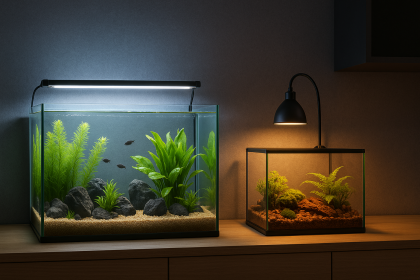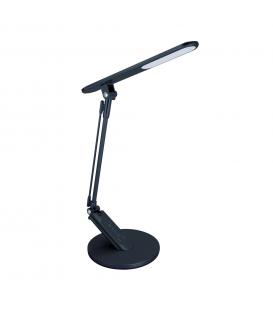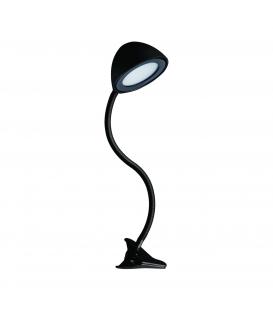Lighting for aquariums and terrariums

Lighting is extremely important for aquariums and terrariums, as it plays a key role in providing optimal conditions for the growth and well-being of plants and animals.
Selecting the right lighting for aquariums and terrariums is crucial for creating a suitable environment for your aquatic or reptilian pets, as well as for the overall aesthetics of the setup. The lighting requirements can vary depending on the type of animals and plants you have, so it's important to research and tailor the lighting to their specific needs.
Creating the perfect lighting environment is crucial for the health and well-being of the inhabitants in both aquariums and terrariums. Whether you're housing aquatic life or terrestrial plants and animals, providing adequate lighting is essential for various biological processes, including photosynthesis, thermoregulation, and behavioral patterns. Let's delve into the details of lighting and lamps for aquariums and terrariums.
Aquarium Lighting:
In aquariums, lighting serves multiple purposes beyond simply illuminating the underwater world. It plays a vital role in supporting the growth of aquatic plants, promoting the natural behavior of fish, and enhancing the overall aesthetic appeal of the tank.
Type of Lighting:
- Full Spectrum LED Lights: These are becoming increasingly popular due to their energy efficiency and ability to provide a wide spectrum of light that promotes both plant growth and enhances the colors of fish.
Intensity and Color Temperature:
- Intensity: The lighting intensity should be appropriate for the type of plants and fish you have. Some plants require higher light intensity than others.
- Color Temperature: For freshwater aquariums, a color temperature between 6500K and 7500K is suitable for plant growth and fish coloration. Marine aquariums might require bluer light in the range of 10000K to 20000K.
Duration and Photoperiod:
- Photoperiod: Mimic natural day and night cycles with a photoperiod of 8-10 hours of light followed by 12-14 hours of darkness. Use timers to ensure consistency.
Specialized Lighting:
- Planted Tanks: If you have live plants, consider lights that offer higher intensity in the blue and red spectrum, as these are critical for photosynthesis.
- Reef Tanks: For coral growth, you might need lights that can provide intense blue and UV light to simulate the natural reef environment.
Terrarium Lighting:
Terrariums house a diverse range of organisms, including plants, insects, amphibians, and reptiles. Proper lighting is vital for maintaining the health of plants and supporting the behaviors of the inhabitants.
Type of Lighting:
- Full Spectrum UVB Lights: Reptiles often require UVB light for the synthesis of vitamin D3, which is vital for calcium metabolism and overall health.
- Basking Lights: Some reptiles need a basking area with a heat lamp to regulate their body temperature.
Intensity and Color Temperature:
- UVB Intensity: The UVB light should be strong enough to provide the required dosage for your reptiles. Different species have different UVB requirements.
- Color Temperature: A warmer color temperature (around 5000K) can mimic the sun's natural color and create a more natural environment.
Duration and Photoperiod:
- Photoperiod: Similar to aquariums, provide a photoperiod that mimics natural day and night cycles. Research the specific needs of your reptiles.
Night Lighting:
- Some reptiles require a period of darkness. If you need nighttime lighting, use a dim red or blue light, as these colors are less likely to disturb your reptile's sleep.
Finally, it is worth noting that the care of lighting in aquariums and terrariums is directly related to the care of other parameters such as temperature, water/air filtration, humidity, substrate, nutrition, etc. Ensuring adequate lighting is only one part of the whole picture.
Remember, proper research is essential to determine the lighting needs of your specific aquarium or terrarium inhabitants. Factors such as the type of animals, plants, and desired aesthetics will influence your lighting choices. It's a good idea to consult with experts or enthusiasts who have experience with the type of setup you're planning.
In conclusion, proper lighting is a critical aspect of maintaining thriving and visually appealing aquariums and terrariums. Whether you're nurturing aquatic plants or providing a habitat for reptiles, the right choice of lighting technology, spectrum, duration, and arrangement can make a significant difference in the health, growth, and behavior of the inhabitants. It's essential to research the specific requirements of your aquatic or terrestrial organisms and tailor the lighting setup accordingly.






